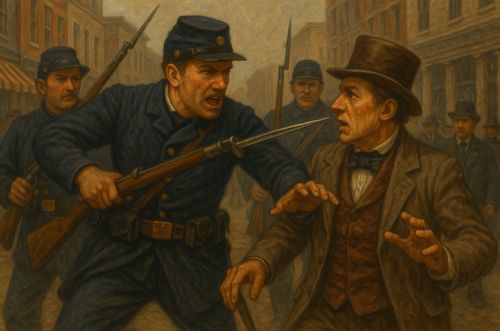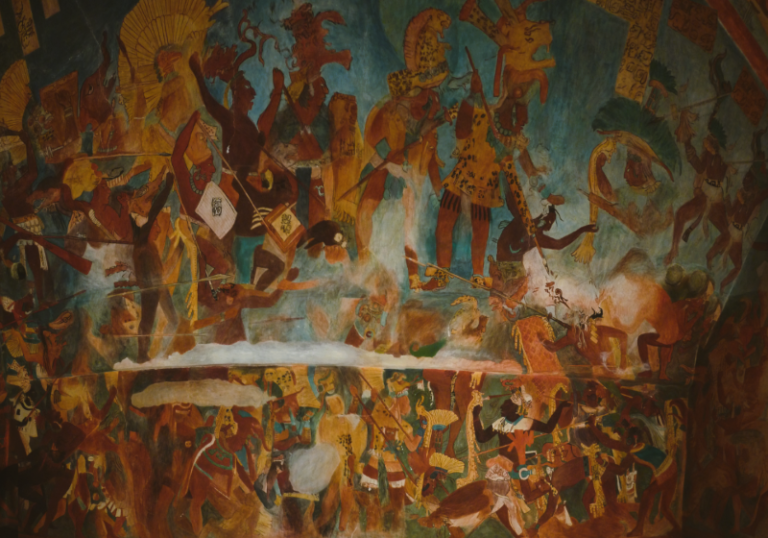

Nineteenth-century Americans cast ballots with soldiers often looming nearby. Political life has always been conducted at the intersection of consent and coercion.

By Matthew A. McIntosh
Public Historian
Brewminate
Introduction: Democracy under Armed Watch
The nineteenth century was a crucible in which the American democratic experiment was repeatedly tested. While the ballot box was celebrated as the foundation of republican government, it was often shadowed by the bayonet. In moments of political crisis, federal and state authorities deployed troops to polling places, protests, and civic spaces. Sometimes these deployments were justified as efforts to maintain order. Often they were spectacles of power, calculated to remind citizens that voting was not only a civic act but one carried out under the potential gaze of armed authority.
Military intimidation did not always require violence. Indeed, its potency often lay in the staging of soldiers in uniform, their presence a visible deterrent rather than a necessary intervention. The nineteenth century reveals the deep ambivalence of American political culture: a nation proclaiming the sovereignty of the people while simultaneously rehearsing spectacles of control that blurred the line between free consent and coerced participation.
The Early Republic and the Legacy of Militia Power

From the beginning, Americans were wary of standing armies. The Revolution had been fought against imperial troops quartered among them, and the Constitution itself reflected anxieties about military power. Yet the fledgling republic quickly discovered the utility of deploying militia forces during moments of unrest. The Whiskey Rebellion of 1794, for instance, saw President Washington personally lead troops into western Pennsylvania to quell tax resistance.1 While justified as a defense of federal law, the episode revealed how military presence functioned symbolically as much as practically. Few shots were fired, but the spectacle of troops marching under presidential command established an early precedent for armed oversight of civic dissent.
This precedent lingered into the nineteenth century. State militias, often politicized, were called upon not merely for defense but to serve as instruments of public order at elections and strikes. Their presence communicated the lesson that democratic participation unfolded under the watchful eye of authority. In this way, military intimidation was woven into the fabric of American political development, not as aberration but as recurring feature.
The Civil War and the Politics of Occupation
The Civil War transformed the relationship between ballots and bayonets. Elections continued during the conflict, but the shadow of military power loomed heavily over them. In border states like Maryland, Union troops were stationed at polling places to deter Confederate sympathizers. Officials justified these deployments as safeguards for loyal voters, but critics denounced them as naked intimidation.2
Nowhere was the tension clearer than in Kentucky and Missouri, where Union generals openly intervened to influence the outcome of elections. Ballots cast under the eyes of armed soldiers blurred the boundary between free choice and coerced loyalty. Lincoln himself defended these measures as necessary to preserve the Union, but the spectacle of democracy conducted beneath bayonets raised troubling questions about the limits of republican liberty in wartime.3
For African Americans, however, military presence was often a guarantee of participation rather than a barrier. The Reconstruction amendments expanded the franchise, but it was Union troops who made voting possible for freedmen in the South. Federal soldiers stood guard at polling places, not to intimidate Black voters, but to protect them from white supremacist violence. The irony is stark: the same presence that represented coercion in some contexts represented emancipation in others.
Reconstruction and the Paradox of Protection

The Reconstruction era provides the clearest window into the dual meaning of military oversight. Federal troops were stationed throughout the South to enforce the rights of freedmen and ensure fair elections. At times, their presence made the difference between mass participation and mass terror. Freedmen, often voting for the first time, cast their ballots under the watchful protection of soldiers whose uniforms symbolized a fragile but real guarantee of equality.4
Yet the same spectacle was seized upon by opponents of Reconstruction to denounce Republican governments as illegitimate. Democrats depicted elections “under bayonets” as evidence of tyranny, claiming that the ballot had been corrupted by military force. Cartoons in Democratic newspapers portrayed Black voters casting ballots with soldiers looming over them, the imagery designed to frame emancipation as occupation.5
The paradox of Reconstruction is that military presence could both secure democracy and undermine its legitimacy. The bayonet could make the ballot possible, but it could also taint the perception of that ballot, feeding narratives of authoritarianism that weakened public confidence.
Labor Unrest and the Militarization of Protest
By the late nineteenth century, the fusion of military power and political life shifted into the realm of labor unrest. Strikes across the industrializing nation often became flashpoints where troops were deployed, sometimes at the request of governors, sometimes at the behest of industrialists. The Great Railroad Strike of 1877 witnessed the deployment of federal troops in cities from Baltimore to Pittsburgh. Officially their role was to restore order, but their presence also communicated the supremacy of capital and state over the grievances of labor.6
At times, these interventions directly intersected with electoral politics. Workers radicalized by strikes and angered by the presence of troops became a significant political constituency. The image of the soldier at the factory gate or the polling place became a potent symbol of the ways in which democracy could be constrained by force. Even when shots were not fired, the visual choreography of uniforms, rifles, and bayonets projected a lesson: dissent had limits, and those limits were guarded by the state.
The Bayonet as Spectacle and the Ballot as Ritual

What emerges from these episodes is not simply the story of coercion but the recognition of politics as theater. Soldiers stationed at polling places did not always prevent citizens from voting. Their presence often mattered less in practice than in perception. The bayonet reminded citizens that the state had the capacity to compel, and that the ritual of the ballot box unfolded within structures of power that could never be ignored.
The nineteenth century was therefore a century of uneasy balance. The same republic that celebrated the sovereignty of the people repeatedly relied upon the presence of armed men to police that sovereignty. Sometimes this preserved order, sometimes it protected the vulnerable, and sometimes it undermined the very principle it claimed to defend.
Conclusion: Democracy in the Shadow of Force
Nineteenth-century Americans cast ballots with soldiers often looming nearby. Political life has always been conducted at the intersection of consent and coercion.
The legacy of military intimidation in nineteenth-century America should not be read only as a betrayal of democratic ideals. It was also an index of their fragility. The republic was young, its institutions contested, its promises unevenly distributed. The bayonet did not always cancel the ballot, but it shaped the conditions under which ballots were cast. That uneasy pairing reveals the paradox of American democracy: liberty proclaimed, yet always haunted by the possibility of force.
Appendix
Footnotes
- Thomas P. Slaughter, The Whiskey Rebellion: Frontier Epilogue to the American Revolution (New York: Oxford University Press, 1986), 234–240.
- Jennifer L. Weber, Copperheads: The Rise and Fall of Lincoln’s Opponents in the North (New York: Oxford University Press, 2006), 142–146.
- James M. McPherson, Battle Cry of Freedom: The Civil War Era (New York: Oxford University Press, 1988), 595–598.
- Eric Foner, Reconstruction: America’s Unfinished Revolution, 1863–1877 (New York: Harper & Row, 1988), 388–393.
- Heather Cox Richardson, The Death of Reconstruction (Cambridge: Harvard University Press, 2001), 104–108.
- Philip S. Foner, The Great Labor Uprising of 1877 (New York: Monad Press, 1977), 56–62.
Bibliography
- Foner, Eric. Reconstruction: America’s Unfinished Revolution, 1863–1877. New York: Harper & Row, 1988.
- Foner, Philip S. The Great Labor Uprising of 1877. New York: Monad Press, 1977.
- McPherson, James M. Battle Cry of Freedom: The Civil War Era. New York: Oxford University Press, 1988.
- Richardson, Heather Cox. The Death of Reconstruction. Cambridge: Harvard University Press, 2001.
- Slaughter, Thomas P. The Whiskey Rebellion: Frontier Epilogue to the American Revolution. New York: Oxford University Press, 1986.
- Weber, Jennifer L. Copperheads: The Rise and Fall of Lincoln’s Opponents in the North. New York: Oxford University Press, 2006.
Originally published by Brewminate, 09.02.2025, under the terms of a Creative Commons Attribution-NonCommercial-NoDerivatives 4.0 International license.


